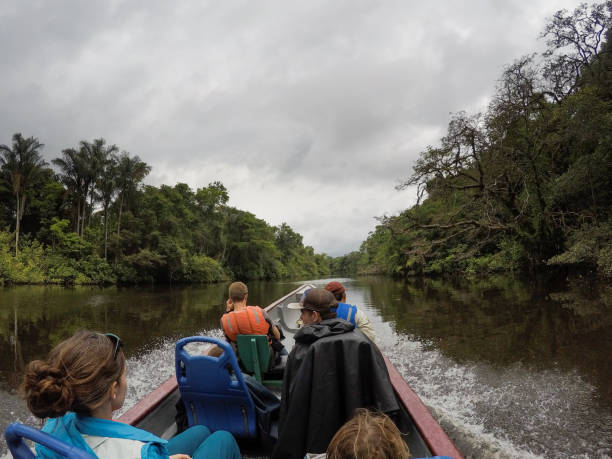Overview of Everglades Airboat Tours
Everglades airboat tours offer a unique and thrilling way to explore one of the most diverse and vibrant ecosystems in the world. Gliding over the waters of this expansive wetland, visitors have the opportunity to experience the natural beauty and encounter a variety of wildlife in their natural habitat.
Importance of Wildlife Spotting in the Everglades
Wildlife spotting is a major highlight of any Everglades airboat tour. The Everglades is home to an incredible array of species, many of which are rare or endangered. Spotting these creatures not only adds excitement to the tour but also provides a deeper appreciation of the ecological importance of this unique region.
History and Significance of the Everglades
Formation and Ecology
The Everglades formed over thousands of years, resulting from a slow-moving river flowing out of Lake Okeechobee and spreading across a vast, flat landscape. This region is characterized by its unique mix of freshwater and saltwater ecosystems, which support a wide range of plant and animal life.
Cultural and Environmental Importance
The Everglades hold significant cultural value, particularly for the indigenous peoples who have lived in and depended on these wetlands for centuries. Environmentally, the Everglades play a crucial role in water filtration, flood control, and providing habitat for numerous species.
The Unique Ecosystem of the Everglades
Diverse Habitats
The Everglades is a mosaic of habitats, including sawgrass marshes, mangrove forests, hardwood hammocks, and coastal lowlands. Each habitat supports different species, contributing to the region’s overall biodiversity.
Key Species of Flora and Fauna
From towering cypress trees to delicate orchids, the plant life in the Everglades is as diverse as its animal inhabitants. Key fauna include alligators, manatees, and a variety of bird species, making the Everglades a paradise for wildlife enthusiasts.
What to Expect on an Everglades Airboat Tour
Description of the Airboat Experience
Airboat tours are conducted on flat-bottomed boats powered by large, rear-mounted propellers. These boats can skim over shallow waters and navigate through dense vegetation, providing access to areas that are otherwise difficult to reach.
Safety and Preparation Tips
Before embarking on an airboat tour, it’s important to follow safety guidelines provided by the tour operator. Wear sunscreen, bring water, and dress appropriately for the weather. Ear protection is often provided due to the noise of the airboat’s engine.
Major Wildlife Attractions
Alligators
Alligators are perhaps the most iconic residents of the Everglades. These impressive reptiles can often be seen basking on the banks or gliding silently through the water. Spotting an alligator in its natural habitat is a thrilling highlight of any tour.
American Crocodiles
While less common than alligators, American crocodiles also inhabit the Everglades. They prefer the brackish waters of the coastal areas and can be distinguished from alligators by their narrower snouts and lighter coloration.
Florida Panthers
The elusive Florida panther, a subspecies of the cougar, is one of the most endangered animals in the Everglades. While sightings are rare, the possibility of encountering one adds an element of excitement and awareness about the importance of conservation efforts.
Manatees
These gentle giants, also known as sea cows, are often spotted in the warmer waters of the Everglades during the winter months. Manatees are slow-moving herbivores that spend much of their time grazing on aquatic plants.
Birdwatching Highlights
Wading Birds: Herons, Egrets, and Spoonbills
The Everglades are a birdwatcher’s paradise, home to numerous wading birds such as herons, egrets, and the striking roseate spoonbill. These birds can often be seen hunting for fish and other small prey in the shallow waters.
Birds of Prey: Ospreys and Bald Eagles
Birds of prey, including ospreys and bald eagles, are also commonly seen in the Everglades. These majestic birds can be observed soaring overhead or perched high in the trees, scanning for their next meal.
Songbirds and Migratory Species
The Everglades are a crucial stopover for many migratory bird species. In addition to resident songbirds, visitors can spot a variety of colorful and melodious migrants, especially during the spring and fall migration periods.
Reptiles and Amphibians
Turtles and Tortoises
Several species of turtles and tortoises inhabit the Everglades, including the Florida box turtle and the softshell turtle. These reptiles can be found basking in the sun or slowly moving through the vegetation.
Snakes and Lizards
The Everglades are home to a variety of snakes and lizards. While some, like the green anole, are common and harmless, others, such as the Burmese python, are invasive species that pose a threat to the ecosystem.
Frogs and Toads
Frogs and toads are abundant in the Everglades, contributing to the region’s rich biodiversity. Their calls, especially during the rainy season, add to the symphony of sounds that characterize the wetlands.
Mammals of the Everglades
White-tailed Deer
White-tailed deer are frequently seen in the Everglades, especially in the hardwood hammocks and prairie areas. These graceful animals are a common sight and an important part of the ecosystem.
River Otters
Playful and curious, river otters can sometimes be spotted in the Everglades’ waterways. Watching these agile swimmers is a delightful experience for tour-goers.
Bobcats and Foxes
While more elusive, bobcats and foxes also inhabit the Everglades. These nocturnal hunters are rarely seen during the day, but their presence is an indicator of a healthy, functioning ecosystem.
Aquatic Life
Fish Species
The waters of the Everglades teem with fish, including bass, catfish, and the unique gar. These fish are a vital food source for many of the birds and reptiles in the area.
Aquatic Plants
Aquatic plants such as water lilies and sawgrass are essential components of the Everglades’ ecosystem. They provide habitat and food for numerous animal species and help maintain water quality.
The Importance of Wetlands
Wetlands like the Everglades play a crucial role in filtering water, mitigating floods, and supporting biodiversity. They are among the most productive ecosystems in the world, providing countless ecological benefits.
Tips for Successful Wildlife Spotting
Best Times to Visit
The best times to visit the Everglades for wildlife spotting are during the dry season, from December to April. During this period, animals are more concentrated around water sources, making them easier to spot.
Essential Gear for Wildlife Observation
Bringing the right gear can enhance your wildlife spotting experience. Binoculars, a camera with a zoom lens, and a field guide to local wildlife are essential items. Don’t forget sunscreen, insect repellent, and plenty of water.
How to Spot and Identify Animals
Patience and a keen eye are key to successful wildlife spotting. Listen for rustling leaves or bird calls, look for movement in the water, and be aware of your surroundings. A knowledgeable tour guide can also provide valuable insights and tips.
Conservation Efforts in the Everglades
National Park Protections
The Everglades National Park, established in 1947, provides critical protection for this unique ecosystem. The park’s regulations help preserve the natural environment and its inhabitants for future generations.
Conservation Organizations
Several organizations, including the Everglades Foundation and the National Audubon Society, work tirelessly to protect and restore the Everglades. Their efforts include habitat restoration, species protection, and public education.
How Tourists Can Help
Visitors can contribute to conservation efforts by following park guidelines, supporting conservation organizations, and spreading awareness about the importance of the Everglades. Responsible tourism practices help ensure the preservation of this precious ecosystem.
The Role of Airboat Tours in Education
Raising Awareness
Airboat tours play a significant role in raising awareness about the Everglades and its wildlife. Tour guides often provide educational information about the ecosystem and conservation efforts.
Engaging the Public
By offering an exciting and interactive experience, airboat tours engage the public and inspire a greater appreciation for nature. This engagement can lead to increased support for conservation initiatives.
Promoting Conservation
Many airboat tour operators are actively involved in conservation efforts. By choosing a tour company that prioritizes sustainability, visitors can contribute to the ongoing protection of the Everglades.
Personal Stories and Testimonials
Memorable Wildlife Encounters
Many visitors have unforgettable wildlife encounters during their airboat tours. From close-up views of alligators to spotting rare birds, these experiences create lasting memories and a deeper connection to nature.
Visitor Experiences
Testimonials from past visitors highlight the excitement and educational value of Everglades airboat tours. Reading about others’ experiences can provide insights and tips for making the most of your own adventure.
Frequently Asked Questions About Everglades Airboat Tours
Are airboat tours safe for all ages?
Yes, airboat tours are generally safe for all ages. Operators provide safety briefings and equipment to ensure a secure experience for everyone. However, it’s always best to check with the tour provider for any age-specific recommendations or restrictions.
What should I bring on an airboat tour?
Essential items to bring include sunscreen, a hat, sunglasses, insect repellent, water, and a camera. Comfortable clothing and shoes suitable for the weather are also important. Some tours may provide ear protection, but it’s a good idea to bring your own just in case.
How close will we get to the wildlife?
The proximity to wildlife can vary, but airboat tours often get visitors quite close to animals like alligators and birds. Guides are experienced in navigating the waters and ensuring a safe distance while still providing excellent viewing opportunities.
Are there eco-friendly airboat tour options?
Yes, some airboat tour operators prioritize eco-friendly practices. These tours focus on minimizing environmental impact and educating guests about the importance of conservation. Look for companies with certifications or commitments to sustainable tourism.
Can I take photos during the tour?
Absolutely! Photography is encouraged during airboat tours. Capturing the stunning landscapes and diverse wildlife is a great way to remember your experience. Just make sure to secure your camera and equipment, as it can get bumpy on the water.
Conclusion
Recap of the Everglades Experience
An Everglades airboat tour offers an unparalleled opportunity to explore one of the most unique and biodiverse ecosystems on the planet. From thrilling wildlife sightings to the serene beauty of the wetlands, the experience is both educational and exhilarating.
Encouragement to Explore and Protect the Everglades
We encourage everyone to embark on an Everglades airboat tour to witness the natural wonders firsthand. By doing so, you contribute to the awareness and protection of this vital ecosystem. Remember, every visit helps support conservation efforts and ensures that the Everglades remain a thriving habitat for generations to come.


